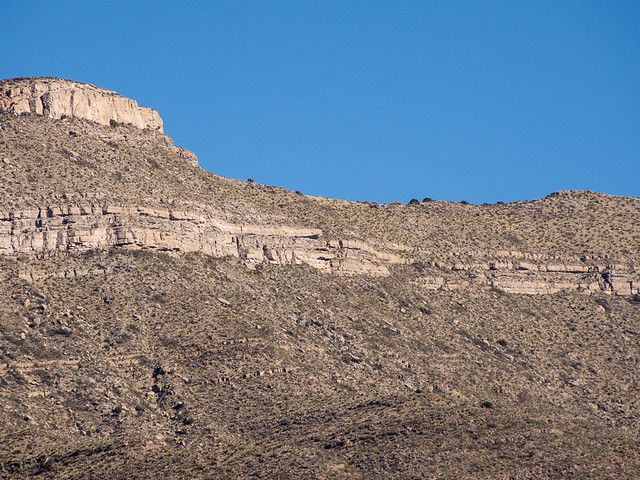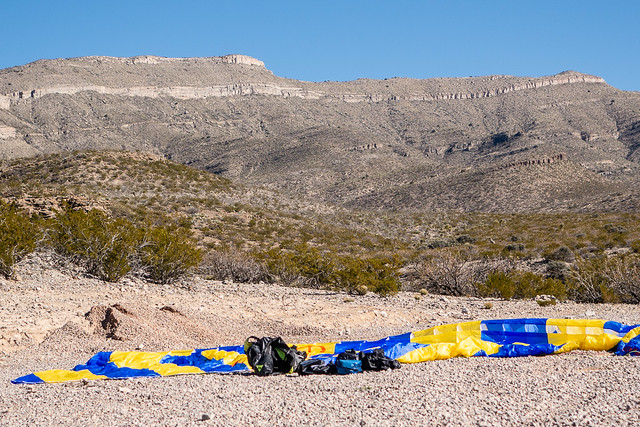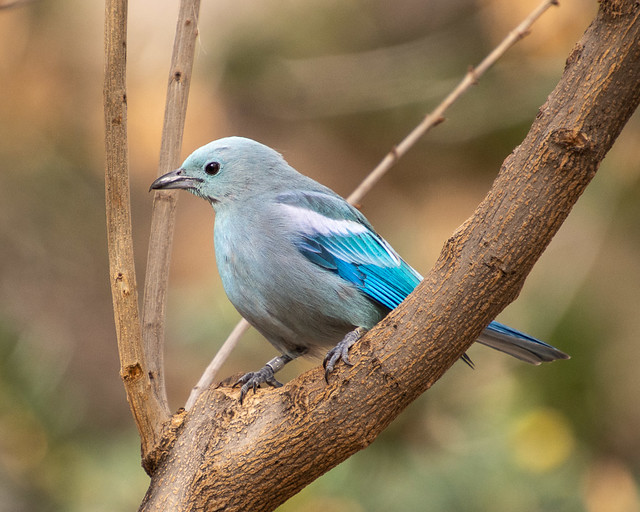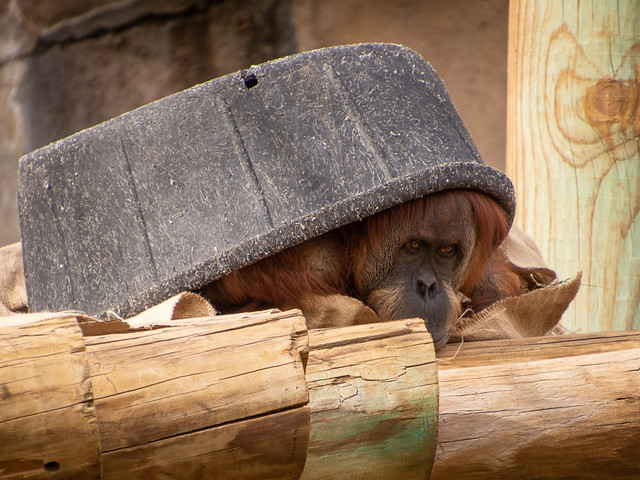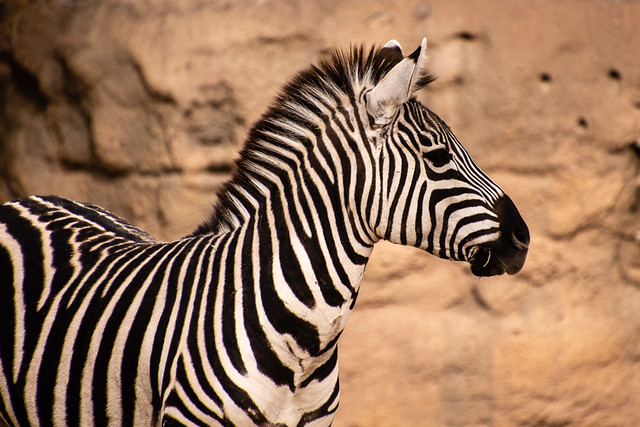I always like visiting Big Bend National Park. My plan was to hang out for a while, but the government shutdown closed the campgrounds and I was evicted. I still had a good few days though. I took a ton of photographs, too many for one post, so I'll start with the nature stuff. Even so, it's a long post since I saw lots of stuff.
Driving into the park, one of the first things I noticed were the yuccas flowering. These are large flower heads - the size of a watermelon. And, as one of the few flowers around, they were attracting lots of attention from the insects. Can you spot the big black carpenter bee?

My favorite hikes this trip were when I just pulled off the road at "interesting" spots and wandered randomly into the desert. I was in little danger of getting lost because I found so many things to look at and photograph that I barely managed one km/hour. (And I had my inReach mini in my pocket and my Garmin Fenix 5s+ gps watch) Although the desert was looking quite bare and lifeless, there was actually quite a lot going on if you looked close.
One of my most exciting finds was this Agile Ground Mantis (at least I think that's what it is). I'm fascinated by praying mantises. I've spotted them in Baja Mexico, Asia, and South America, but never in North America. This wasn't your typical green praying mantis, and it was on the ground rather than on vegetation like most mantids. From a distance I thought it was a grasshopper. But looking closely, it had the iconic eyes (like a damselfly) and front legs (albeit folded). I don't usually like to interfere with wildlife at all, but I don't worry so much about insects, and I admit I had to give this guy a few nudges to get it to move to where I could get a decent photograph. Apparently, Agile Ground Mantis are even found in the Okanagan, and are Canada's only native mantis.

At one point I heard a "chirping" in a bush and approached carefully, hoping to catch sight of the bird. But I got closer and closer and there was no bird. The chirping stopped, but if I stood still it would start up again. Maybe it was an insect? Sure enough, I discovered the bush (one of the few with green leaves) had multiple grasshoppers in it. I assume that's what was making the noise, although I didn't actually catch them in the act. According to iNaturalist, they are Creosote Bush Grasshoppers. They were actually quite colorful, but blended in with the leaves very well and were hard to spot. Apparently there is an evolutionary arms race between the Creosote Bush Grasshoppers and the Creosote bushes. The bushes produce chemicals so the leaves are inedible, but the grasshoppers evolve ways to eat them anyway.

There were other kinds of grasshoppers around that would jump or fly up from the ground as you walked. I think these are Pallid winged grasshoppers. They were well camouflaged.

In several of the ocotillos there were spider webs with a suspended nest/house about 5 cm (2 in) long. They were constructed of quite an assortment of materials - leaves, twigs, stones, insect parts. The opening appeared to be at the bottom, but between the web and the thorns it was hard to get to where you could look into the bottom.

I assumed they were some sort of spiders, based on the web, but despite examining a number of them, I hadn't actually seen the spiders. Finally, my curiosity got the better of me and I got a long thin twig that I could thread through the web and poke the "nest". At first nothing happened, but with a little more poking, sure enough, out came the spider. (The stick also let me keep my distance in case it was poisonous.)
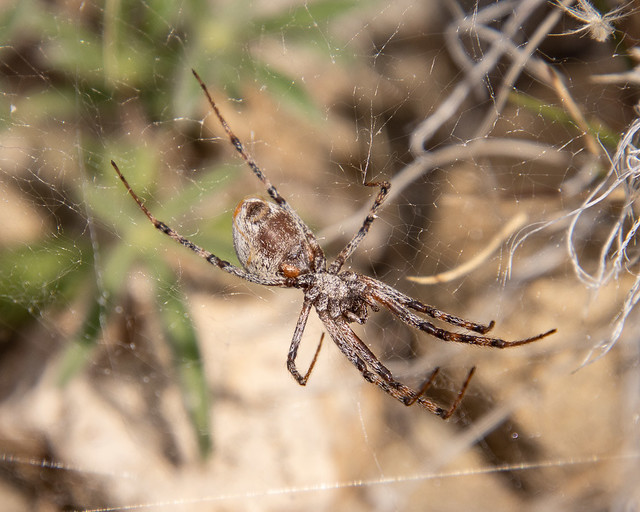
It was on the underside of the web so I couldn't get a view of the top of the spider. So far no one on iNaturalist has identified it and I haven't had any luck searching on the web. They seemed to be quite common, at least in the area I was in.
I tried poking a couple of the other nests, but nothing came out. Possibly the nests were abandoned. One difference with the nest with the spider is that there were multiple dead grasshoppers on the ground beneath it. (You can see them at the bottom of this photo.) That makes sense since they were the most abundant food source.
I noticed another spider web in a bush and went to look closer. This time the spider was sitting out in the open. And even better, its web was full of baby spiders. iNaturalist identified it as a Green Lynx Spider. These spiders are hunters rather than web builders, but it appears they make a nursery web and guard it, like the fishing spiders. The spiky legs apparently help it grasp its prey and also deter its prey from biting back.

Near the river I noticed something white in a tree. Again, it was hard to get close because the tree (acacia?) had sharp thorns. It turned out to be a snail.

I'm not sure if this is a dry land snail, or if it was left over from when the river flooded. Later I saw scattered broken shells on the ground. That makes me suspect they are probably aquatic ones left over from flooding.
Further from the river, I again saw something white on the ground. But this time it turned out to be a dead millipede. I spotted quite a few of these, some intact, some broken in pieces. I wonder if the live millipedes are white, or if the dead shells just get bleached white. They were quite hard shells, like a snail. I didn't see any live ones - they're probably hiding under rocks. I wonder what killed these ones, and why they were out in the open?

The butterflies were much less cooperative. I kept seeing small orange ones flitting about, but they refused to sit still to be photographed. Eventually I managed to get a couple of photos. I laughed when they were identified (iNaturalist) as Sleepy Orange butterflies. They certainly didn't act "sleepy"!

These little pale ones were also relatively common, and also tricky to photograph.

I only saw one each of these - a Buckeye (Dark Tropical?) and a Painted Lady:


And a moth of some sort:

I was surprised to see a dragonfly in the desert - I normally associate them with water. I guess it was only a few kilometers from the river. One thing that makes dragonflies slightly easier to photograph (despite being speedier than butterflies) is that they often return to the same perch (where they hunt from). So I you're patient and stand still, they may return to be photographed, like this Variegated Meadowhawk did.

There weren't a lot of flowers blooming in mid-winter in the desert, but there were a few, and the honey bees were visiting them.

From a distance they looked the same, but if you look closely they are slightly different. They are both darkling beetles. The first is a Desert Stink Beetle that is named because of it's habit of raising it's rear and squirting a noxious fluid.


One of these was dead (although in perfect shape), whereas the other was alive and well. Can you tell which is which?
I'm a little surprised I saw so many different insects since the temperature was dropping below freezing at night. But it was getting warm enough during the day (e.g. +20c) that perhaps the ground was staying above freezing.
I stayed in the small, quiet Cottonwood Campground at the south west edge of the park. When we stayed here previously we found that great horned owls would visit at night. Perhaps the bare area of the campground makes a good hunting ground. So the first evening, I wandered around looking up into the cottonwoods to see if I could find an owl. Happily, I succeeded. It was getting dark and it was high up in the tree, but I managed one identifiable shot.
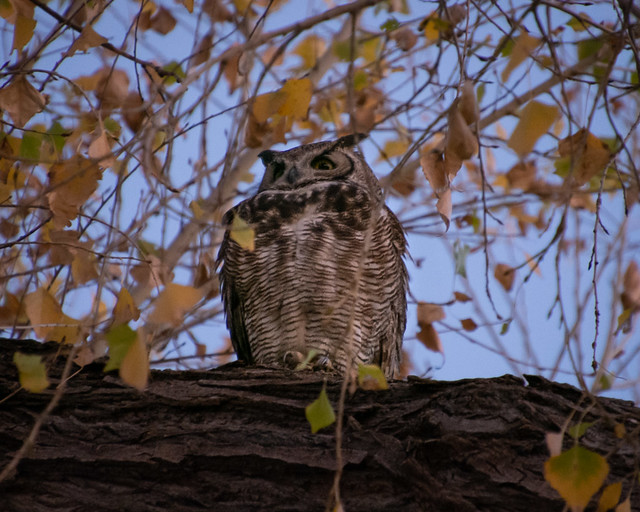
The next evening I went out earlier but couldn't spot anything. I figured it probably didn't show up till dusk so I sat and waited. I was getting ready to give up when I heard hooting and in flew a big owl. Unfortunately it landed in one of the cottonwoods that still had its leaves and I couldn't see it. But it was still neat to see it fly in.
Another feature of the campground was that it was visited by Vermilion Flycatchers. They were another one that was tricky to photograph as they seldom perched for more than a few seconds. I took a ton of photos of them, none of which are great (if you look close), but they are such colorful birds I couldn't resist.


Red birds seem to be a theme here. I also spotted Northern Cardinals:

and Desert Cardinals: (love that hairdo!)

Although I tend to favor animals over plants, I still find the details of the desert flora fascinating. For example, the Ocotillos shed their leaves when it's dry and regrow them (in a matter of days) when there is moisture. When I was there, they were shedding them.


You quickly learn that it's not safe to brush up against plants like it is at home. Almost every plant has thorns.
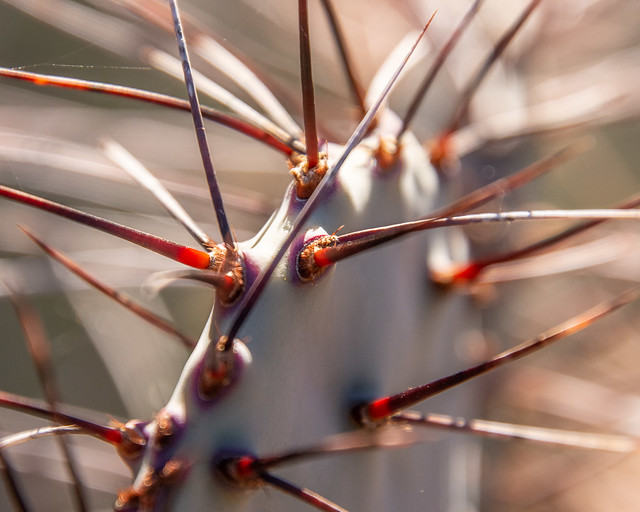

When I was a kid I used to think of the desert as giant sand dunes. This is quite a different desert, almost lush in its own way. There is a surprising amount of life.
See all 61 photos
Driving into the park, one of the first things I noticed were the yuccas flowering. These are large flower heads - the size of a watermelon. And, as one of the few flowers around, they were attracting lots of attention from the insects. Can you spot the big black carpenter bee?

My favorite hikes this trip were when I just pulled off the road at "interesting" spots and wandered randomly into the desert. I was in little danger of getting lost because I found so many things to look at and photograph that I barely managed one km/hour. (And I had my inReach mini in my pocket and my Garmin Fenix 5s+ gps watch) Although the desert was looking quite bare and lifeless, there was actually quite a lot going on if you looked close.
One of my most exciting finds was this Agile Ground Mantis (at least I think that's what it is). I'm fascinated by praying mantises. I've spotted them in Baja Mexico, Asia, and South America, but never in North America. This wasn't your typical green praying mantis, and it was on the ground rather than on vegetation like most mantids. From a distance I thought it was a grasshopper. But looking closely, it had the iconic eyes (like a damselfly) and front legs (albeit folded). I don't usually like to interfere with wildlife at all, but I don't worry so much about insects, and I admit I had to give this guy a few nudges to get it to move to where I could get a decent photograph. Apparently, Agile Ground Mantis are even found in the Okanagan, and are Canada's only native mantis.

At one point I heard a "chirping" in a bush and approached carefully, hoping to catch sight of the bird. But I got closer and closer and there was no bird. The chirping stopped, but if I stood still it would start up again. Maybe it was an insect? Sure enough, I discovered the bush (one of the few with green leaves) had multiple grasshoppers in it. I assume that's what was making the noise, although I didn't actually catch them in the act. According to iNaturalist, they are Creosote Bush Grasshoppers. They were actually quite colorful, but blended in with the leaves very well and were hard to spot. Apparently there is an evolutionary arms race between the Creosote Bush Grasshoppers and the Creosote bushes. The bushes produce chemicals so the leaves are inedible, but the grasshoppers evolve ways to eat them anyway.

There were other kinds of grasshoppers around that would jump or fly up from the ground as you walked. I think these are Pallid winged grasshoppers. They were well camouflaged.

In several of the ocotillos there were spider webs with a suspended nest/house about 5 cm (2 in) long. They were constructed of quite an assortment of materials - leaves, twigs, stones, insect parts. The opening appeared to be at the bottom, but between the web and the thorns it was hard to get to where you could look into the bottom.

I assumed they were some sort of spiders, based on the web, but despite examining a number of them, I hadn't actually seen the spiders. Finally, my curiosity got the better of me and I got a long thin twig that I could thread through the web and poke the "nest". At first nothing happened, but with a little more poking, sure enough, out came the spider. (The stick also let me keep my distance in case it was poisonous.)

It was on the underside of the web so I couldn't get a view of the top of the spider. So far no one on iNaturalist has identified it and I haven't had any luck searching on the web. They seemed to be quite common, at least in the area I was in.
I tried poking a couple of the other nests, but nothing came out. Possibly the nests were abandoned. One difference with the nest with the spider is that there were multiple dead grasshoppers on the ground beneath it. (You can see them at the bottom of this photo.) That makes sense since they were the most abundant food source.
I noticed another spider web in a bush and went to look closer. This time the spider was sitting out in the open. And even better, its web was full of baby spiders. iNaturalist identified it as a Green Lynx Spider. These spiders are hunters rather than web builders, but it appears they make a nursery web and guard it, like the fishing spiders. The spiky legs apparently help it grasp its prey and also deter its prey from biting back.

Near the river I noticed something white in a tree. Again, it was hard to get close because the tree (acacia?) had sharp thorns. It turned out to be a snail.

I'm not sure if this is a dry land snail, or if it was left over from when the river flooded. Later I saw scattered broken shells on the ground. That makes me suspect they are probably aquatic ones left over from flooding.
Further from the river, I again saw something white on the ground. But this time it turned out to be a dead millipede. I spotted quite a few of these, some intact, some broken in pieces. I wonder if the live millipedes are white, or if the dead shells just get bleached white. They were quite hard shells, like a snail. I didn't see any live ones - they're probably hiding under rocks. I wonder what killed these ones, and why they were out in the open?

The butterflies were much less cooperative. I kept seeing small orange ones flitting about, but they refused to sit still to be photographed. Eventually I managed to get a couple of photos. I laughed when they were identified (iNaturalist) as Sleepy Orange butterflies. They certainly didn't act "sleepy"!

These little pale ones were also relatively common, and also tricky to photograph.

I only saw one each of these - a Buckeye (Dark Tropical?) and a Painted Lady:


And a moth of some sort:

I was surprised to see a dragonfly in the desert - I normally associate them with water. I guess it was only a few kilometers from the river. One thing that makes dragonflies slightly easier to photograph (despite being speedier than butterflies) is that they often return to the same perch (where they hunt from). So I you're patient and stand still, they may return to be photographed, like this Variegated Meadowhawk did.

There weren't a lot of flowers blooming in mid-winter in the desert, but there were a few, and the honey bees were visiting them.

From a distance they looked the same, but if you look closely they are slightly different. They are both darkling beetles. The first is a Desert Stink Beetle that is named because of it's habit of raising it's rear and squirting a noxious fluid.


One of these was dead (although in perfect shape), whereas the other was alive and well. Can you tell which is which?
I'm a little surprised I saw so many different insects since the temperature was dropping below freezing at night. But it was getting warm enough during the day (e.g. +20c) that perhaps the ground was staying above freezing.
I stayed in the small, quiet Cottonwood Campground at the south west edge of the park. When we stayed here previously we found that great horned owls would visit at night. Perhaps the bare area of the campground makes a good hunting ground. So the first evening, I wandered around looking up into the cottonwoods to see if I could find an owl. Happily, I succeeded. It was getting dark and it was high up in the tree, but I managed one identifiable shot.

The next evening I went out earlier but couldn't spot anything. I figured it probably didn't show up till dusk so I sat and waited. I was getting ready to give up when I heard hooting and in flew a big owl. Unfortunately it landed in one of the cottonwoods that still had its leaves and I couldn't see it. But it was still neat to see it fly in.
Another feature of the campground was that it was visited by Vermilion Flycatchers. They were another one that was tricky to photograph as they seldom perched for more than a few seconds. I took a ton of photos of them, none of which are great (if you look close), but they are such colorful birds I couldn't resist.


Red birds seem to be a theme here. I also spotted Northern Cardinals:

and Desert Cardinals: (love that hairdo!)

Although I tend to favor animals over plants, I still find the details of the desert flora fascinating. For example, the Ocotillos shed their leaves when it's dry and regrow them (in a matter of days) when there is moisture. When I was there, they were shedding them.


You quickly learn that it's not safe to brush up against plants like it is at home. Almost every plant has thorns.


When I was a kid I used to think of the desert as giant sand dunes. This is quite a different desert, almost lush in its own way. There is a surprising amount of life.
See all 61 photos
